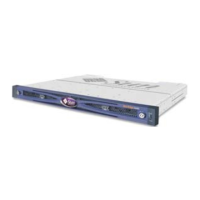Chapter 5 Configuration Overview 5-7
6. (Optional) Configure host channels as drive channels. See “Configuring FC
Channels as a Host or Drive Channel (Optional)” on page 6-5.
7. Confirm or change the Fibre Connection Option (point-to-point or loop). See
“Choosing Loop or Point-to-Point Fibre Connection” on page 6-7.
8. Revise or add host IDs on host channels. See “Editing and Creating Additional
Host IDs (Optional)” on page 6-8.
The IDs assigned to controllers take effect only after the controller is reset.
9. Delete default logical drives and create new logical drives. See “Creating Logical
Drives” on page 6-21.
10. (Optional) In dual-controller configurations only, assign logical drives to the
secondary controller to load-balance the two controllers. See “Changing a Logical
Drive Controller Assignment (Optional)” on page 6-28.
Caution – In single-controller configurations, do not disable the Redundant
Controller setting and do not set the controller as a secondary controller. The
primary controller controls all firmware operations and must be the assignment
of the single controller. If you disable the Redundant Controller Function and
reconfigure the controller with the Autoconfigure option or as a secondary
controller, the controller module becomes inoperable and will need to be replaced.
Note – While the ability to create and manage logical volumes remains a feature of
arrays for legacy reasons, the size and performance of physical and logical drives
have made the use of logical volumes obsolete. Logical volumes are unsuited to
some modern configurations, such as Sun Cluster environments, and do not work in
those configurations. Avoid using logical volumes and use logical drives instead. For
more information about logical drives, refer to the Sun StorEdge 3000 Family RAID
Firmware User’s Guide.
11. (Optional) Partition the logical drives. See “Partitioning a Logical Drive
(Optional)” on page 6-31.
12. Map each logical drive partition to an ID on a host channel, or apply a host LUN
filter to the logical drives. See “Mapping Logical Drive Partitions to Host LUNs”
on page 6-35 for more information.

